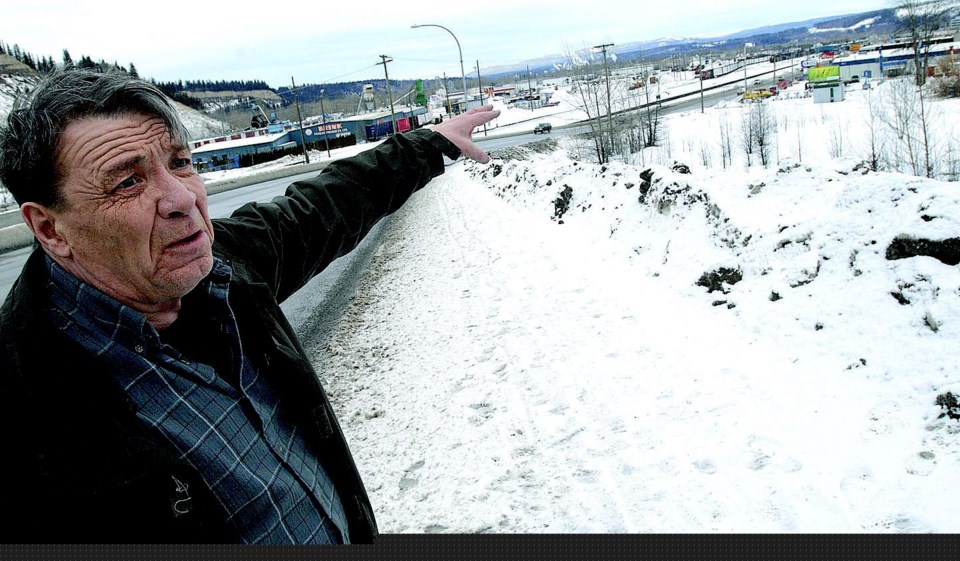Local business owner, economist and former real estate agent David Pearson is calling on the City of Prince George to sell many of its prime real estate holdings downtown.
Pearson, who holds a master's degree in economics, said he took an interest in the issue last year and began assessing the city's land holdings within walking distance of his office - the area from Fifth Avenue to First Avenue, Cassier Street to Burden Street.
What he found was large number of unused or underused properties which could be sold and put to use, he said.
"The sewer and water and roads and police ... all the things needed to service the land is there, but we're not getting any taxes from it," Pearson said. "I want to push the city, with this [core service] review, to use this land or sell it. The cost of doing it is less than the value of the land."
In open letter to city council, Pearson identified some of the city's unused lands in the area.
One such property is located at 2133 First Ave. The approximately eight-acre light industrial site is occupied by a small shed.
B.C. Assessment placed the value of the land at just over a million dollars. The shed's assessed value was $7,400.
The city also owns five residential lots along Fifth Avenue at 480 Burden St., 485 and 490 Alward St., 493 Wainwright St. and 2090 Fifth Ave. According to B.C. Assessment, each of the serviced lots was valued at approximately $76,500.
"Fifth Avenue is not an attractive throughway. These lots could at least be a temporary greenbelt," Pearson said. "That kind of land we should be doing something with, or selling it off."
A treed ridgetop along Third Avenue from Cassier Street to Alward Street could accommodate at least 16 nice homes with views of the Nechako River cutbanks, Pearson said.
"You could put 10 lovely homes overlooking the embankment there. There is at least a row of 100-foot-depth housing [lots] there," he said.
Currently the area is primarily used by homeless people who sleep there in the summer, he added.
"These anomalies are seen all through Prince George," Pearson said. "The reason I chose this area is because it's close to my office, not because there is a large number of these properties."
Pearson said in addition to land which could be sold and developed as stand-alone projects, he found unused alleys, inaccessible lots and other land which could be sold to neighbouring landowners to merge into existing lots.
The money generated from selling the lands could be used to lower the city's debt or reinvested into other city facilities, Pearson said. In addition, once the land is privately owned the owners would be required to pay property taxes to the city.
Prince George has a disproportionately high amount of vacant or underused land, he said. The first step towards developing it is getting it into private hands, Pearson said.
City response
Mayor Shari Green was not available for comment, but city spokesperson Chris Bone said the city's real estate holdings will be included in the core service review launched by the city last month.
City real estate manager Ian Wells said the city owns approximately 1,200 properties within city limits, but the majority are parks, public green spaces, undevelopable slopes, utility sites, future road right of ways or being held for community use. Others are undevelopable for various reasons.
"Less than 10 per cent of our holdings are for development land, and that might be on the high side. It might be as low as five per cent," Wells said.
The industry site at 2133 First Ave. is a former power station which was demolished in 1999, Wells said. The site could be developed, but is heavily contaminated and would need extensive, and expensive, environmental remediation.
The five residential lots along Fifth Avenue were acquired to facilitate the widening of the main arterial route, he said.
"It's a lot easier if you acquire the land before a house goes up on it," Wells said.
One thing the city is looking at is how to beautify or provide community use on lands held by the city for future use, he said.
The ridgetop along Third Avenue has been assessed and has slope stability issues which could pose a serious risk to development on, and below, the slope, Wells said.
Other seemingly empty sites have water and sewer infrastructure below ground, he added, which city crews must have access to.
"On an ongoing basis we review our land assets to determine what is marketable, and where we want to encourage development under the [Official Community Plan]. We add value by rezoning it and trying to resolve issues so they know they're getting a developable site," Wells said. "When we sell lands ... we place restrictions on title to ensure development. We don't want to sell the land for holding or speculative investment ... that could actually be a barrier to development."
The University Heights residential development, Westgate Mall, Wood Innovation and Design Centre and Canadian Cancer Society Kordyban Lodge are all examples of city-owned properties being prepared and managed to attract development, he said.
Another example is last month the city began accepting bids on a 16.85 acre plot of land at the end of Barnes Road in College Heights. The city had acquired the property in the 1970s for future development, and had recently received substantial developer interest in the area.
"We've been acquiring property quietly. If larger projects come along, we can facilitate them a lot quicker, because they don't have to deal with a number of smaller land owners," Wells said.


